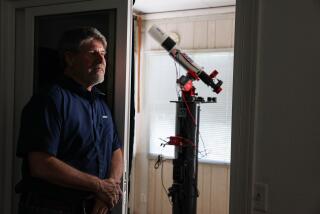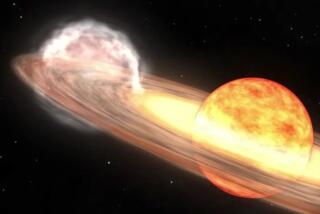Christmas Star--It Continues to Be a Subject to Ponder : Astronomy: Some say it never existed. Others speculate it may have been a planet, a conjunction of planets, a nova or a comet.
- Share via
The clues are, at best, tantalizingly vague, leaving some room for speculation, and much more room for imagination. As chronicled in the Gospel of Matthew:
“And lo, the star, which they saw in the east, went before them, till it came and stood over where the young child was. When they saw the star, they rejoiced with exceeding great joy.”
For those who take this sole biblical account of the wise men pursuing the Christmas Star on faith, of course, there is no argument. The star was there, as reported, period.
But for others, including astronomers trying to decide what kind of light in the sky might have been seen as an omen, a Christmas Star, no proposed answer quite fits.
Was it actually a star? Or perhaps a nova? A supernova? Planet? Conjunction of planets? A comet?
Astronomer John Mosley, at the Griffith Observatory, said: “We may never know. What astronomers do is look for astronomical events that might have been interpreted by (ancient) astrologers as an omen. But what you find depends on when you look; you have to know when this sign appeared.”
No one knows exactly the year--much less the day, week or month--of Jesus’ birth. Without a firm date, anything goes.
Still, Mosley said for purposes of his observatory program for the public, “we make the assumption that it was an actual astronomical event, and we search for the most plausible one.”
Based on that idea, “we look in the years 3 and 2 B.C.” and begin plotting the planets’ positions from there. The results, he said, indicate the Christmas Star could have been a conjunction of the planets Jupiter and Venus.
But to be fair, Mosley said, there are some who have profound doubts about the reality of the star story. In fact, “most historians believe this is a story invented later to add to the pageantry of Christ’s birth.”
Mosley, who studied the question closely for his book “The Christmas Star,” said that much of what occurs at Christmas seems to exploit older, deep-rooted pagan traditions. He noted that Christmas “is celebrated at the time of the winter solstice” and was perhaps a deliberate attempt by the early church “to give Christian meaning to long-existing pagan holidays.”
Yet the story of the Christmas Star, even if mythical, frequently sets scholars off on a search that has continued, in fits and starts, for centuries.
One of the latest looks into this enigma was made by a non-astronomer, former member of Parliament and honorary director of the Friends of Friendless Churches, Ivor Bulmer-Thomas. In the December issue of the Quarterly Journal of the Royal Astronomical Society, Bulmer-Thomas argues that the Christmas Star was actually just Jupiter.
He cites the fact that Jupiter, as seen from Earth, at certain times seems to come to a stop in the sky, reverse its direction for a few weeks, and then resume forward motion. This is seen because of the relative motions of the two planets as they orbit the sun.
Conversely, astronomer Brian Marsden at the Harvard-Smithsonian Center for Astrophysics in Cambridge, Mass., thinks the best explanation for a Christmas Star is Venus, which sometimes ranks among the brightest lights in the sky.
“It could have been something fairly ordinary, like Venus, or something a little bit bizarre or exotic, like a conjunction” of several planets coming together in the sky, he said.
One of the most intriguing suggestions--that the Christmas Star may be seen again--came in 1977 from astronomer John Parkinson and two colleagues at the Mullard Space Laboratory, in England. They argued that the Christmas Star was a small, super-dense star, orbiting around another star and eating up its companion’s hydrogen.
In their report in the Royal Astronomical Society’s journal, Parkinson, Richard Stephenson of Newcastle University and David Clark of the Royal Greenwich Observatory said the explosion that was the Christmas Star may have been seen and recorded by Chinese astronomers in 5 B.C.
The Chinese records indicate, they said, that the bright new star was visible for 70 days. A bigger event, a supernova explosion, involves the cataclysmic destruction of a massive star. That would be visible for too long to be the Christmas Star.






